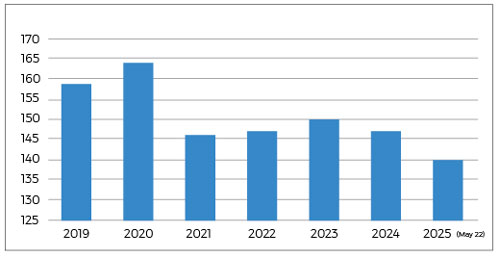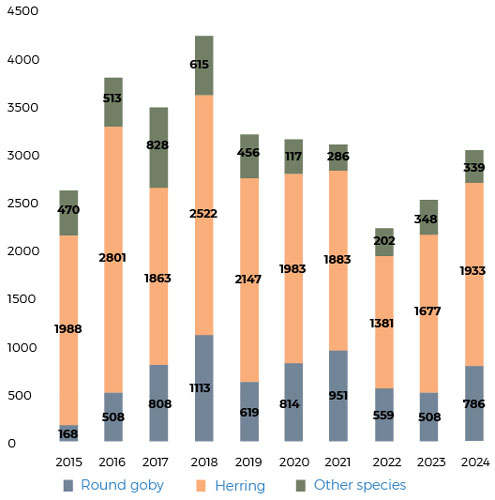This article was featured in Eurofish Magazine 5 2025.
Since 2022, Latvia’s coastal fishers have had access to direct development support from the European Maritime, Fisheries and Aquaculture Fund (EMFAF), the first time such targeted aid has been available. This has not only helped the sector survive but also significantly boosted revenues.
Coastal fishing in Latvia is relatively small-scale, providing local communities with jobs and fresh fish for the local market. Out of Latvia’s average annual catch of 49,000 tonnes, only about 3,000 tonnes (just over 6%) are landed by coastal fishers. Officially, 140 coastal fishers are registered, but in reality no more than 50 depend on it for their livelihood. Over the past decade, their numbers have fallen by a third. The work is tough, income unstable, and fishing opportunities are limited by both weather and strict national regulations. For example, in the Gulf of Riga a full ban for 2.5 months each year restricts coastal fishing, while seals increasingly damage gear and catches. As a result, many fishers abandoned the trade and sought work abroad.
Lobbying pays off
Five years ago, the outlook began to change. The association Mazjūras zvejnieki (Small Sea Fishers) lobbied successfully for a special EMFAF programme, Support for Coastal Fishers. Initially funded with €2.3 million, later topped up with another €1 million, the scheme provided grants of up to €30,000 per project, fully funded and paid in advance. Despite the modest size of the programme, it has revived many small-scale fishing enterprises and restored faith in the sector’s future. Data from the Rural Support Service (RSS), which administers the scheme, show that revenues of 45 supported companies rose from €1.14 million to €2.06 million over four years.
Rinalds Vācers, Director of the RSS Fisheries and State Aid Department, explains that previously, coastal fishers had almost no access to EU support, which undermined the sector’s survival. Now, investments enable them to process the fish themselves – chilling, gutting, smoking, vacuum-packing – and sell at a higher value. At a time of declining fish stocks, he says, every fish matters. Support has also funded more selective, seal-safe fishing gear and improved working conditions. Equipment has been purchased to make handling nets easier, and vehicles for transporting fish and gear have been acquired, among other improvements. For the first time since EU accession, support has reached coastal fishers in a way that gives them and their families hope that fishing can still provide a living – and the belief that fishers are needed, Mr Vācers says.
From wheelbarrows to quad bikes
Edgars Zviedris, a ninth-generation fisher from Saulkrasti, recalls how a few years ago he pushed his nets to the sea in a wheelbarrow never dreaming he would one day afford proper transport. Through three projects under the coastal support scheme, his enterprise Silzviedri has bought a quad bike for hauling nets and catches, a trailer for selling fish, an ice machine, and storage containers. His income has doubled in three years, allowing him not only to support his family but also to modernise gear.


Across the Gulf of Riga, Ivars Cīrulis of Ivars C has also carried out three projects, purchasing a quad bike, a computer for catch reporting, a small processing unit, and a refrigerated van with EMFAF and LEADER support. The van allows him to transport fish from more distant fishing grounds near Ventspils back to his home and markets in Riga. “I could never have earned enough from fishing alone to buy all this equipment, which now makes my work easier and provides a more reliable income,” he says.
Ongoing challenges and new threats
The association Mazjūras zvejnieki has been central to these successes. Its chairman, Andris Cīrulis, was awarded the national prize “Lielais loms” in recognition of his work. The group has launched the website www.piekrasteszivis.lv, spreading awareness on fish consumption, and cooperating with research institutions on new selective, seal-proof fishing gear.
Yet looming EU control regulations, due in 2028, are raising alarm. Requirements such as species-level catch reporting at sea, electronic weighing and labelling, and GPS tracking of transport are seen as unrealistic for Latvia’s small-scale fishers, who typically work in 4–8 metre open boats with only basic equipment. “The officials who wrote these rules clearly don’t realise our fishers go out in tiny boats on open seas”, says Mr Cīrulis, “I’d gladly take them out to show what our work is really like”. For Latvia’s few dozen remaining coastal fishers, the hope is that recent EU support will not be undone by impractical regulations.
Iveta Tomsone
Head of Publications,
Latvian Rural -Advisory and Training Centre





